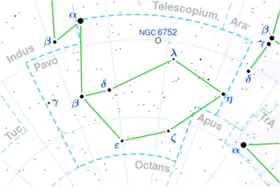Astronomy:Lambda Pavonis
| Observation data Equinox J2000.0]] (ICRS) | |
|---|---|
| Constellation | Pavo |
| Right ascension | 18h 52m 13.03427s[1] |
| Declination | −62° 11′ 15.3324″[1] |
| Apparent magnitude (V) | 4.22[2] (4.00 - 4.26)[3] |
| Characteristics | |
| Spectral type | B2Ve[4] or B2II–IIIe[5] |
| U−B color index | −0.88[6] |
| B−V color index | −0.15[2] |
| Variable type | γ Cas[3] |
| Astrometry | |
| Radial velocity (Rv) | +9.0±4.1[7] km/s |
| Proper motion (μ) | RA: −1.86[1] mas/yr Dec.: −13.02[1] mas/yr |
| Parallax (π) | 2.28 ± 0.18[1] mas |
| Distance | 1,400 ± 100 ly (440 ± 30 pc) |
| Absolute magnitude (MV) | −3.97[2] |
| Details | |
| Mass | 12.5[8] M☉ |
| Radius | 9±1[9] (polar) R☉ |
| Luminosity | 8,450[2] L☉ |
| Temperature | 20,300[10] K |
| Rotational velocity (v sin i) | 190[11] km/s |
| Other designations | |
| Database references | |
| SIMBAD | data |
λ Pavonis, Latinized as Lambda Pavonis, is a single,[13] variable star in the southern constellation of Pavo. It is a blue-white hued star that is faintly visible to the naked eye with an apparent visual magnitude that fluctuates around 4.22.[2] This object is located approximately 1,400 light years from the Sun, based upon parallax. It is a member of the Scorpius–Centaurus association.[14]

This is a massive Be star, a rapidly rotating hot blue star which has developed a gas disk around it. It is a γ Cassiopeiae variable or shell star which has occasionally brightened to magnitude 4.0.[3] The stellar classification of B2Ve[4] suggests it is a B-type main-sequence star that is generating energy through core hydrogen fusion. This star is spinning rapidly with a projected rotational velocity of 190 km/s.[11] This is giving the star an oblate shape with an equatorial bulge that is an estimated 10% larger than the polar radius.[16] Lambda Pavonis has 12.5[8] times the mass of the Sun and nine times the Sun's polar radius.[9] It is radiating 8,450[2] times the luminosity of the Sun from its photosphere at an effective temperature of 20,300 K.[10]
Variations in signals coming from Lambda Pavonis have led to a debate on whether it is a binary, single or pulsating variable star.[14]
References
- ↑ 1.0 1.1 1.2 1.3 1.4 Van Leeuwen, F. (2007). "Validation of the new Hipparcos reduction". Astronomy and Astrophysics 474 (2): 653–664. doi:10.1051/0004-6361:20078357. Bibcode: 2007A&A...474..653V. Vizier catalog entry
- ↑ 2.0 2.1 2.2 2.3 2.4 2.5 Anderson, E.; Francis, Ch. (2012). "XHIP: An extended hipparcos compilation". Astronomy Letters 38 (5): 331. doi:10.1134/S1063773712050015. Bibcode: 2012AstL...38..331A. Vizier catalog entry
- ↑ 3.0 3.1 3.2 Samus, N. N. et al. (2017). "General Catalogue of Variable Stars". Astronomy Reports. 5.1 61 (1): 80–88. doi:10.1134/S1063772917010085. Bibcode: 2017ARep...61...80S.
- ↑ 4.0 4.1 Levenhagen, R. S.; Leister, N. V. (2006). "Spectroscopic analysis of southern B and Be stars". Monthly Notices of the Royal Astronomical Society 371 (1): 252–262. doi:10.1111/j.1365-2966.2006.10655.x. Bibcode: 2006MNRAS.371..252L.
- ↑ Samus, N. N. et al. (2009). "General Catalogue of Variable Stars (Samus+ 2007-2013)". VizieR On-Line Data Catalog: B/GCVS. Originally Published in: 2009yCat....102025S 1. Bibcode: 2009yCat....102025S.
- ↑ Mermilliod, J. C. (2006). "Homogeneous Means in the UBV System (Mermilliod 1991)". VizieR On-Line Data Catalog: II/168. Originally Published in: Institut d'Astronomie 2168. Bibcode: 2006yCat.2168....0M.Vizier catalog entry
- ↑ Gontcharov, G. A. (2006). "Pulkovo Compilation of Radial Velocities for 35 495 Hipparcos stars in a common system". Astronomy Letters 32 (11): 759–771. doi:10.1134/S1063773706110065. Bibcode: 2006AstL...32..759G.
- ↑ 8.0 8.1 Tetzlaff, N. et al. (2011). "A catalogue of young runaway Hipparcos stars within 3 kpc from the Sun". Monthly Notices of the Royal Astronomical Society 410 (1): 190–200. doi:10.1111/j.1365-2966.2010.17434.x. Bibcode: 2011MNRAS.410..190T. Vizier catalog entry
- ↑ 9.0 9.1 Vieira, R. G. et al. (January 2017). "The life cycles of Be viscous decretion discs: time-dependent modelling of infrared continuum observations". Monthly Notices of the Royal Astronomical Society 464 (3): 3071–3089. doi:10.1093/mnras/stw2542. Bibcode: 2017MNRAS.464.3071V.
- ↑ 10.0 10.1 Hohle, M. M. et al. (2010). "Masses and luminosities of O- and B-type stars and red supergiants". Astronomische Nachrichten 331 (4): 349. doi:10.1002/asna.200911355. Bibcode: 2010AN....331..349H.
- ↑ 11.0 11.1 Glebocki, R.; Gnacinski, P. (2005). "VizieR Online Data Catalog: Catalog of Stellar Rotational Velocities (Glebocki+ 2005)". VizieR On-Line Data Catalog: III/244. Originally Published in: 2005csss...13..571G 3244. Bibcode: 2005yCat.3244....0G. Vizier catalog entry
- ↑ "lam Pav". SIMBAD. Centre de données astronomiques de Strasbourg. http://simbad.u-strasbg.fr/simbad/sim-basic?Ident=lam+Pav.
- ↑ Eggleton, P. P.; Tokovinin, A. A. (2008). "A catalogue of multiplicity among bright stellar systems". Monthly Notices of the Royal Astronomical Society 389 (2): 869. doi:10.1111/j.1365-2966.2008.13596.x. Bibcode: 2008MNRAS.389..869E.
- ↑ 14.0 14.1 Levenhagen, R. S. et al. (2011). "Spectroscopic variabilities in λ Pavonis". Astronomy & Astrophysics 533: 75. doi:10.1051/0004-6361/201116590. Bibcode: 2011A&A...533A..75L.
- ↑ "MAST: Barbara A. Mikulski Archive for Space Telescopes". Space Telescope Science Institute. https://mast.stsci.edu/portal/Mashup/Clients/Mast/Portal.html.
- ↑ Belle, G. T. (2012). "Interferometric observations of rapidly rotating stars". The Astronomy and Astrophysics Review 20 (1): 51. doi:10.1007/s00159-012-0051-2. Bibcode: 2012A&ARv..20...51V.
 |

